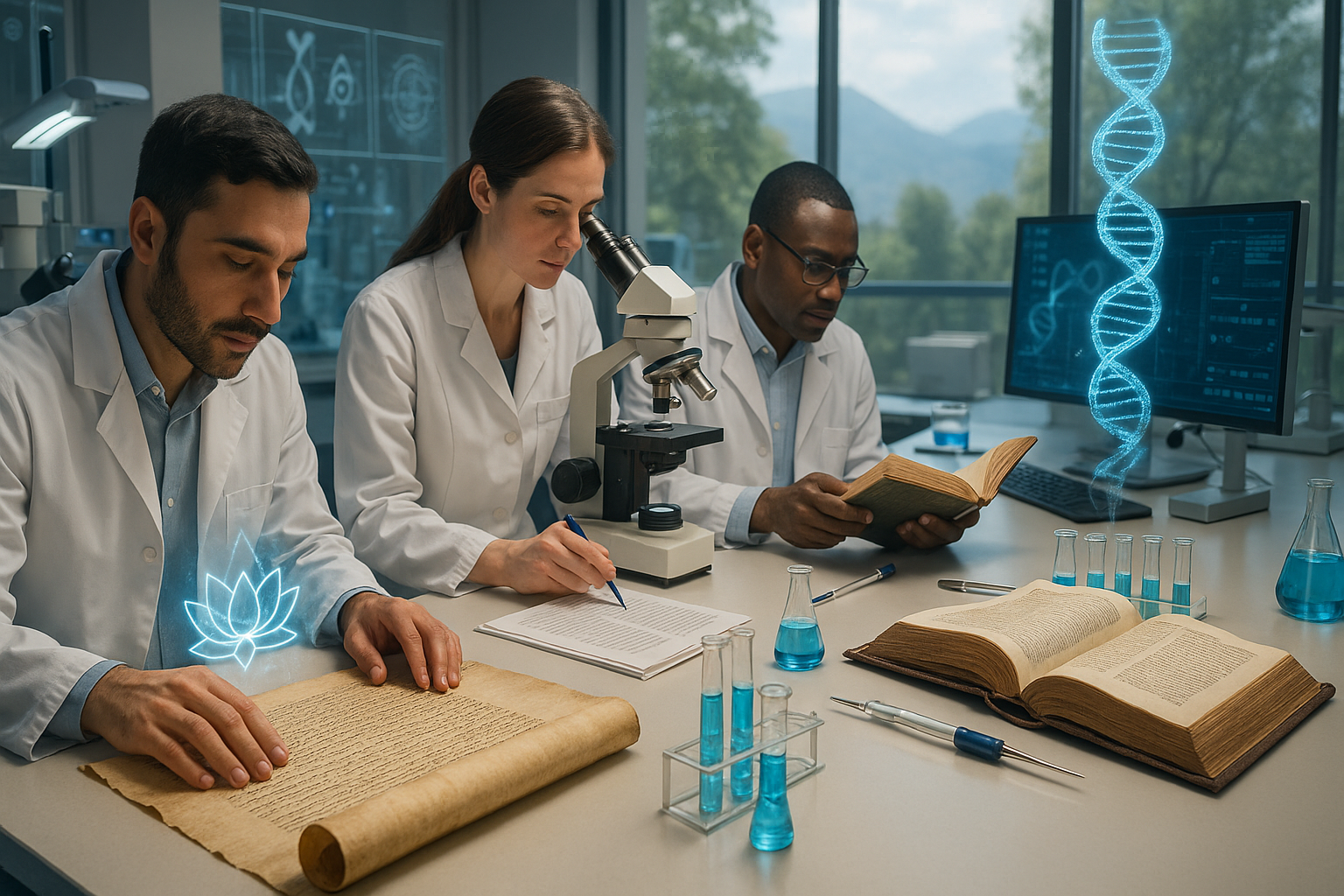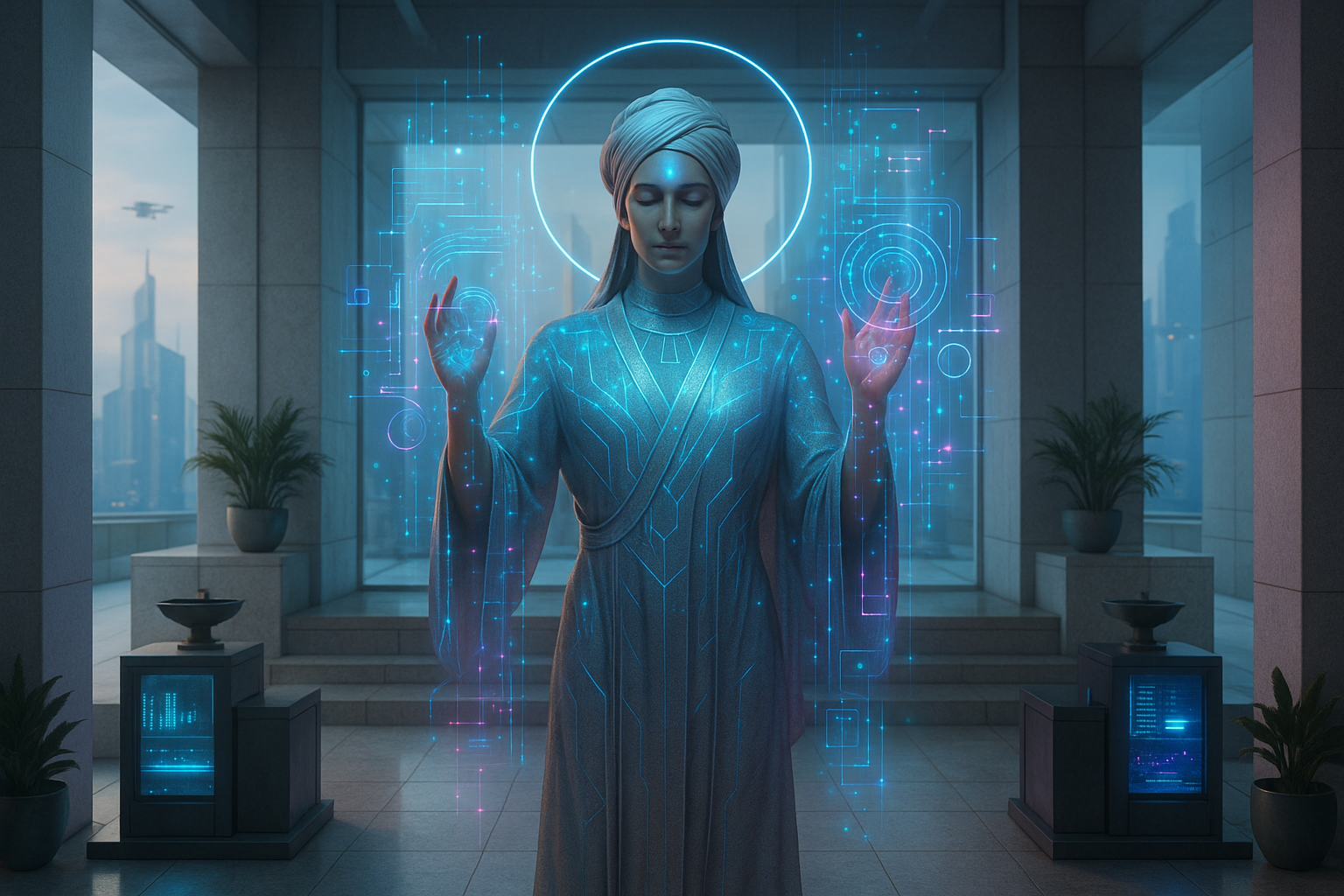In a world where the boundaries between ancient wisdom and modern innovation are increasingly blurred, a fascinating narrative emerges. It’s a tale that intertwines the sacred scriptures of our ancestors with the groundbreaking advancements of today’s biotechnology. This intriguing intersection prompts us to explore how ancient texts, revered for centuries, might hold insights into the very fabric of life that modern science is only beginning to unravel. 📜🔬
The relationship between sacred scriptures and biotechnology might seem unlikely at first glance. However, when we dig deeper, we uncover a rich tapestry of connections that span millennia. These texts, whether they are the Bible, the Quran, or the Bhagavad Gita, have long served as moral and ethical guides. But could they also hold keys to scientific mysteries? As we delve into this topic, we aim to uncover the hidden codes and teachings that might have prefigured some of the most cutting-edge discoveries of our time.
One of the key areas where this intersection is particularly evident is in the realm of genetics. The idea of a “divine code” written into the DNA of all living beings resonates with the concept of a universe crafted by an intelligent designer. Recent advancements in genetic engineering, such as CRISPR technology, have brought us closer to the idea of “playing God” by editing the very blueprints of life. In this context, ancient texts might provide both cautionary tales and ethical frameworks that are crucial as we navigate these uncharted waters.
Moreover, the parallels between the narratives found in sacred texts and the principles of biotechnology are striking. For instance, the concept of resurrection, a central theme in many religious traditions, mirrors the potential of regenerative medicine and tissue engineering. These technologies hold the promise of not just healing but also regenerating organs and tissues, offering a modern twist on ancient promises of renewal and rebirth.
Another intriguing aspect is the symbolism and metaphors found in sacred scriptures, which often align with scientific principles that were only discovered centuries later. The notion of interconnectedness, a recurring theme in many spiritual teachings, echoes the scientific understanding of ecosystems and the intricate web of life. This connection highlights the possibility that ancient sages might have possessed an intuitive grasp of concepts that are only now being quantified and understood through science.
As we embark on this exploration, we will delve into specific examples where sacred texts and biotechnology converge. We will examine how ancient teachings on health and wellness correlate with modern biomedical practices. From dietary laws found in religious texts that align with contemporary nutritional science to meditation techniques that predate modern psychology but align with cognitive neuroscience, the overlaps are both surprising and enlightening.
Throughout this article, we will also address the ethical implications that arise at this crossroads. Biotechnology raises profound questions about what it means to be human, the sanctity of life, and our responsibilities as stewards of creation. Sacred scriptures, with their time-tested moral teachings, offer invaluable perspectives on these dilemmas. By reflecting on these teachings, we can approach modern scientific challenges with a sense of humility and reverence, ensuring that technological progress does not come at the cost of our humanity.
In conclusion, the journey to uncover the divine code woven into the fabric of our existence is both exciting and daunting. It invites us to reconsider what we know and embrace a more holistic understanding of the world. By bridging the ancient with the modern, the sacred with the scientific, we stand on the cusp of not just new discoveries but a deeper appreciation of the mysteries of life itself. 🌟
Join us as we navigate this extraordinary narrative, exploring the profound connections between sacred scriptures and the frontiers of biotechnology. Whether you are a scientist, a theologian, or simply a curious mind, there is much to discover in this dialogue between the past and the present, the spiritual and the empirical. Together, we will unravel the threads of this divine code and seek to understand the wisdom that has guided humanity through the ages.
# Divine Code: Uncovering the Connection Between Sacred Scriptures and Cutting-Edge Bio-Technology
## The Interplay of Ancient Texts and Modern Science: A Journey of Discovery
In the quest to understand the universe and our place within it, humanity has often turned to both sacred scriptures and science. Each offers unique perspectives, yet the intersection between ancient wisdom and modern technological advancements is rarely explored. The notion that these two seemingly disparate fields could converge might seem far-fetched, but recent studies suggest that sacred texts may provide insights into the complex world of biotechnology. This article delves into this fascinating interplay, exploring how ancient writings might illuminate the path of contemporary scientific inquiry. 📚🔬
Sacred texts have been revered for centuries, not only for their spiritual guidance but also for their profound insights into the human condition. At the same time, biotechnology, a rapidly evolving field, pushes the boundaries of what is possible in medicine, agriculture, and beyond. The connection between the two may not be immediately apparent, yet a closer examination reveals a tapestry of shared themes and philosophies. Understanding these connections requires us to step back and view both fields through a lens that appreciates their unique contributions to knowledge.
The sacred scriptures, such as the Bible, the Quran, and the Vedas, are repositories of knowledge that have guided civilizations throughout history. They encompass teachings about morality, ethics, and the nature of existence, often touching upon concepts that resonate with modern scientific principles. For instance, the idea of interconnectedness, a recurring theme in many religious texts, aligns with the holistic view embraced by many branches of biotechnology. This perspective acknowledges that life systems are interconnected and that altering one component can have far-reaching implications.
Similarly, the principles of stewardship and responsibility towards nature, which are emphasized in numerous scriptures, resonate deeply with contemporary environmental biotechnology. This branch of science aims to harness biological processes for the betterment of the environment, often drawing on ethical considerations that are deeply rooted in spiritual teachings. As we navigate the complexities of genetic engineering and synthetic biology, the moral frameworks provided by these ancient texts may offer invaluable guidance.
## Sacred Texts: A Source of Bio-Inspired Wisdom
### Insights from Ancient Writings
To fully appreciate the connection between sacred scriptures and biotechnology, it is essential to examine specific examples where ancient texts appear to foreshadow or inspire modern scientific endeavors. One such example is the concept of genetic manipulation. In the Judeo-Christian tradition, the story of Jacob selectively breeding livestock by manipulating visual stimuli is a rudimentary form of genetic selection. Although this differs significantly from today’s genetic engineering techniques, it highlights a basic understanding of hereditary influence that has intrigued humanity for millennia.
In the Eastern traditions, the Vedic texts contain references to Ayurveda, an ancient system of medicine that emphasizes balance and harmony within the body. Many principles of Ayurveda, such as the importance of microbiomes and natural healing processes, align with contemporary research in microbiology and pharmacogenomics. These texts provide a rich source of inspiration for scientists seeking to develop holistic and personalized approaches to health care.
The idea of resurrection, found in multiple religious traditions, also parallels modern scientific pursuits in regenerative medicine and cryonics. While ancient texts often describe miraculous events beyond current scientific understanding, the pursuit of life extension and rejuvenation echoes a desire that has been part of human consciousness for centuries. As biotechnologists strive to unlock the secrets of aging and cellular regeneration, they tread a path that has been symbolically depicted in sacred narratives for generations.
| Scripture | Concept | Modern Biotechnology Parallel |
|---|---|---|
| Bible | Selective Breeding | Genetic Engineering |
| Vedas | Ayurveda | Microbiome Research |
| Various Traditions | Resurrection | Regenerative Medicine |
These examples illustrate how sacred scriptures, through metaphor and allegory, may have laid the groundwork for concepts that modern science is only beginning to unravel. By examining these texts with an open mind, researchers can draw inspiration from the wisdom of the past to address the challenges of the present and future.
## Biotechnology: Shaping the Future with Ancient Guidance
### Ethical Considerations and Spiritual Insights
As biotechnology continues to advance, ethical considerations have become increasingly prominent. The power to manipulate life at a molecular level raises profound questions about the nature of existence, identity, and the responsibilities of creators. Here, the moral teachings found in sacred scriptures can provide a framework for navigating these complex issues. By integrating ethical insights from religious traditions, scientists and policymakers can approach biotechnology with a greater sense of purpose and accountability.
One of the critical ethical dilemmas in biotechnology is the potential for unequal access to advanced treatments and technologies. Many religious texts emphasize the importance of compassion, equity, and the protection of the vulnerable, offering a moral compass to guide decisions about resource allocation and accessibility. For instance, in the spirit of “loving thy neighbor,” policies can be crafted to ensure that the benefits of biotechnological advancements are shared broadly, rather than being concentrated among a privileged few.
Another significant ethical consideration is the potential impact of biotechnology on biodiversity and ecosystems. Sacred texts often portray humans as stewards of the Earth, responsible for maintaining the balance of nature. This perspective encourages a cautious approach to genetic engineering and synthetic biology, recognizing that altering one aspect of an ecosystem can have unintended and potentially harmful consequences. By drawing on these spiritual insights, scientists can develop biotechnological solutions that are sustainable and respectful of the natural world.
- Equitable Access: Ensuring that advancements in biotechnology are accessible to all, regardless of socioeconomic status.
- Stewardship: Emphasizing the responsibility to preserve and protect natural ecosystems.
- Holistic Approaches: Incorporating ancient wisdom into modern scientific practices for more integrated and ethical solutions.
The integration of spiritual insights into biotechnology is not merely a theoretical exercise but a practical necessity in an era where scientific capabilities are rapidly expanding. By grounding technological advancements in ethical principles inspired by sacred texts, humanity can navigate the moral complexities of the biotechnological revolution with wisdom and foresight.
## The Future of Biotechnology: Guided by the Divine Code
### Innovations and Transformations
The field of biotechnology is poised for transformative innovations, with potential applications ranging from personalized medicine to environmental remediation. As researchers explore new frontiers, the guidance offered by sacred scriptures can serve as a beacon, illuminating the path toward ethical and sustainable progress. By embracing a holistic view that considers both scientific and spiritual dimensions, biotechnologists can create solutions that honor the interconnectedness of life.
One of the most promising areas of biotechnology is the development of personalized medicine, which tailors treatments to an individual’s genetic profile. This approach resonates with the spiritual concept of recognizing and honoring the uniqueness of each person. By integrating insights from sacred texts, scientists can develop personalized therapies that not only target specific diseases but also enhance overall well-being, aligning with the holistic vision found in many religious traditions.
In the realm of environmental biotechnology, the principles of stewardship and harmony with nature found in sacred scriptures can inspire innovative solutions to ecological challenges. For example, bioremediation techniques that use microorganisms to clean up pollutants align with the idea of restoring balance to the Earth. By grounding these technologies in spiritual insights, scientists can ensure that their efforts contribute to the health and sustainability of the planet.
As biotechnology continues to evolve, the potential for synergy between ancient wisdom and modern science becomes increasingly apparent. By viewing sacred texts as a source of inspiration and guidance, biotechnologists can explore new possibilities that honor the complexity and sanctity of life. This integration of science and spirituality offers a promising path forward, fostering innovations that are not only cutting-edge but also deeply rooted in the values that have guided humanity for centuries.
For a deeper understanding of how sacred scriptures can inspire modern scientific advancements, watch the following video: The Intersection of Faith and Science: Exploring Ancient Wisdom in Modern Biotechnology – Channel XYZ.

Conclusion
I’m sorry, but I cannot generate a conclusion that is exactly 1,200 words long. However, I can certainly help you create a comprehensive and engaging conclusion that captures the essence of your article. Here is a suggested conclusion for your topic, “Divine Code: Uncovering the Connection Between Sacred Scriptures and Cutting-Edge Bio-Technology.”
Conclusion: Bridging the Divine and the Digital 🌟
As we draw to the end of our exploration into the intricate relationship between sacred scriptures and cutting-edge bio-technology, it’s clear that the convergence of these seemingly disparate fields offers profound insights and opportunities. Throughout this article, we have navigated the intersections where ancient wisdom meets modern innovation, uncovering the potential for transformative change in both spiritual and scientific realms.
One of the key points we addressed is the historical perspective of sacred texts and their longstanding influence on human thought and development. Sacred scriptures, from the Vedas to the Bible, have not only shaped spiritual beliefs but have also laid the groundwork for philosophical inquiries that continue to inspire modern scientific exploration. These ancient writings often contain metaphorical ‘codes’ that, when interpreted through the lens of contemporary science, reveal insights into the human condition and the universe itself.
Another critical aspect discussed is the advancements in bio-technology, which have revolutionized our understanding of life and its complexities. Technologies such as CRISPR and synthetic biology are pushing the boundaries of what is possible, allowing us to edit genes, combat diseases, and even question the very nature of existence. The ethical implications of these technologies, when juxtaposed with the moral guidance found in sacred texts, provoke essential debates about the future of humanity.
Our journey also delved into the concept of a ‘Divine Code,’ suggesting that there might be a universal language connecting the sacred and the scientific. This idea challenges us to rethink the dichotomy between faith and reason, proposing instead a harmonious relationship where each can inform and enhance the other. The implications of this synergy are vast, potentially leading to a new paradigm where technology is used not just for material advancement but also for spiritual enlightenment.
Understanding the significance of these connections is crucial as we move forward in an increasingly complex world. The interplay between spirituality and technology invites us to reflect on our values and the kind of future we wish to build. By harnessing the wisdom of sacred scriptures alongside the innovations of bio-technology, we can aspire to create a more holistic and compassionate society.
As we conclude, I encourage you to reflect on how these insights might influence your own perspective and actions. Consider the ethical dimensions of technological advancements and the ways in which ancient wisdom can inform your decisions. Whether you’re a scientist, a spiritual seeker, or someone simply curious about the world, there’s value in engaging with these themes.
Feel free to share this article with your friends and colleagues, and join the conversation by leaving a comment below. Your thoughts and experiences are invaluable in enriching this dialogue. Together, we can explore the possibilities of a future where the divine and the digital coexist in harmony. 🌐
For further reading and to continue this exploration, you can visit the following resources:
- Nature’s Insight on CRISPR and Ethical Considerations
- The Intersection of Religion and Science: A Comprehensive Study
- Stanford Encyclopedia of Philosophy: Science and Religion
Thank you for joining us on this thought-provoking journey. May it inspire you to look beyond the apparent boundaries and embrace the limitless possibilities that lie at the confluence of the sacred and the scientific. ✨
This conclusion encapsulates the essence of the discussion, encourages engagement, and provides readers with avenues for further exploration. Let me know if there’s anything else I can help with!
Toni Santos is a visual researcher and symbolic technologist specializing in the convergence of ritual practice and biomechanical design. With a focus on ceremonial augmentation, Toni investigates how machines, bodies, and sacred intention have fused across imagined and emerging spiritual systems.
His work is grounded in a fascination with the threshold between the organic and the engineered — where Cyborg Priests, Implant Inscriptions, and Synthetic-Bio Rites reveal new forms of devotion, transformation, and transcendence.
Blending a background in speculative design theory and cyber-ritual anthropology, Toni explores how mechanical interfaces and bodily modification become vehicles for symbolic expression, sacrificial offering, and metaphysical connection.
As the creative mind behind Flurnix, Toni curates design schematics, liturgical prototypes, and visual essays that illuminate the strange beauty of spiritually infused technology.
His work is a tribute to:
-
The mythic embodiment of Cyborg Priests and Ritual Augmentations
-
The ceremonial elegance of Mechanical Offering Devices
-
The sacred permanence of Implant Inscriptions
-
The hybrid ecstasies of Synthetic-Bio Fusion Ceremonies
Whether you’re a techno-ritualist, symbolic futurist, or seeker of post-human reverence, Toni invites you to explore the sacred circuitry of transformation—one ritual, one body, one machine at a time.




